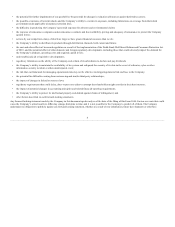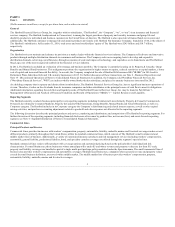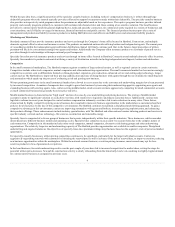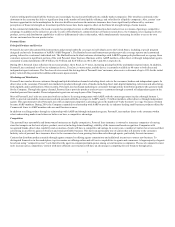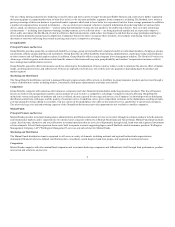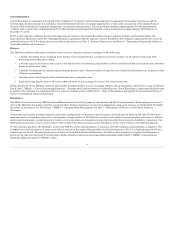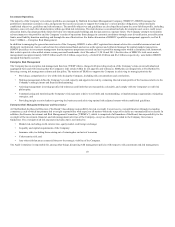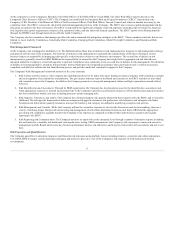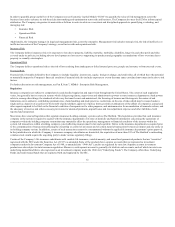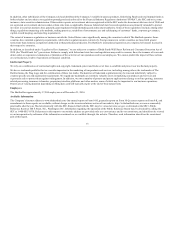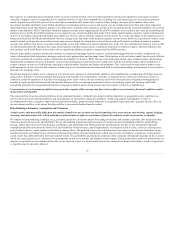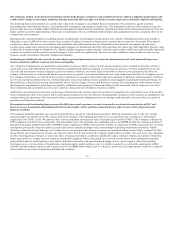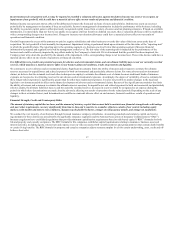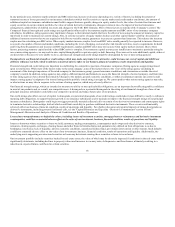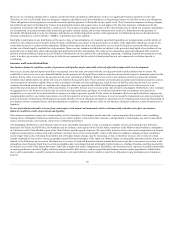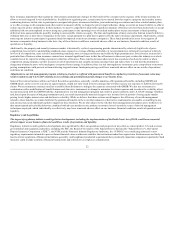The Hartford 2014 Annual Report Download - page 14
Download and view the complete annual report
Please find page 14 of the 2014 The Hartford annual report below. You can navigate through the pages in the report by either clicking on the pages listed below, or by using the keyword search tool below to find specific information within the annual report.
Investing in The Hartford involves risk. In deciding whether to invest in The Hartford, you should carefully consider the following risk factors, any of which
could have an adverse effect on the business, financial condition, results of operations, or liquidity of The Hartford and could also impact the trading price of
our securities. The Hartford may also be subject to other risks and uncertainties that are not specifically described below, which may have an adverse effect on
the business, financial condition, results of operations, or liquidity of The Hartford. This information should be considered carefully together with the other
information contained in this report and the other reports and materials filed by The Hartford with the Securities and Exchange Commission (“SEC”). The
following risk factors have been organized by category for ease of use, however many of the risks may have impacts in more than one category. These
categories, therefore, should be viewed as a starting point for understanding the significant risks facing us and not as a limitation on the potential impact of
the matters discussed. Risk factors are not necessarily listed in order of importance.
Unfavorable conditions in our operating environment, including general economic and global capital market conditions, including financial and capital
markets risks, such as changes in interest rates, credit spreads, equity prices, market volatility, foreign exchange rates, commodities prices and real estate
market deterioration, may have a material adverse effect on our business, financial condition, results of operations, and liquidity.
The Company’s investment portfolio and insurance liabilities are sensitive to changes in global capital market conditions. Stressed conditions or disruptions
in global capital markets can directly impact our business, financial condition, results of operations, and liquidity as well as impact the economic
environment. Weak economic conditions, such as high unemployment, low labor force participation, lower family income, higher tax rates, lower business
investment and lower consumer spending may have adversely affected or may in the future adversely affect the demand for insurance and financial products,
as well as their profitability in some cases. Weak economic conditions are also likely to result in the persistence of a low interest rate environment as well as
volatility in other global capital market conditions, which will continue to pressure our investment results.
One important exposure to equity risk relates to the potential for lower earnings associated with our operations in Mutual Funds and Talcott Resolution, such
as U.S. variable annuities, where fee income is earned based upon the fair value of the assets under management. Should equity markets decline from current
levels, assets under management and related fee income will be reduced. Certain of our products have guaranteed benefits that increase our potential
obligation and statutory capital exposure when equity markets decline. Sustained declines in equity markets may result in the need to utilize significant
additional capital to support these products and adversely affect our ability to support our other businesses.
A sustained low interest rate environment would pressure our net investment income and could result in lower margins and lower estimated gross profits on
certain products. New and renewal business for our property and casualty and group benefits products is priced based on prevailing interest rates. As interest
rates decline, pricing targets will tend to increase to offset the lower anticipated investment income earned on invested premiums. Conversely, as interest
rates rise, pricing targets will tend to decrease to reflect higher anticipated investment income. Such changes in pricing may affect our competitiveness in the
marketplace, and in turn, written premium and earnings margin achieved. In addition, due to the long-term nature of the liabilities within our Group Benefits
and Talcott Resolution operations, such as structured settlements and guaranteed benefits on variable annuities, sustained declines in long-term interest rates
subjects us to reinvestment risks, increased hedging costs, spread compression and capital volatility. A rise in interest rates, in the absence of other
countervailing changes, will reduce the market value of our investment portfolio and, if long-term interest rates were to rise dramatically certain products
within our Talcott Resolution segment might be exposed to disintermediation risk. Disintermediation risk refers to the risk that our policyholders may
surrender their contracts in a rising interest rate environment, requiring us to liquidate assets in an unrealized loss position. An increase in interest rates can
also impact our tax planning strategies and, in particular, our ability to utilize tax benefits to offset certain previously recognized realized capital losses.
Our exposure to credit spreads primarily relates to changes in market price of fixed income instruments associated with changes in credit spreads. If issuer
credit spreads widen significantly and retain wide levels over an extended period of time, other-than-temporary impairments and decreases in the market
value of our investment portfolio will likely result. In addition, losses may also occur due to volatility in credit spreads. When credit spreads widen, we incur
losses associated with credit derivatives where the Company assumes exposure. When credit spreads tighten, we incur losses associated with derivatives
where the Company has purchased credit protection. If credit spreads tighten significantly, the Company's net investment income associated with new
purchases of fixed maturities may be reduced. In addition, a reduction in market liquidity can make it difficult to value certain of our securities when trading
becomes less frequent. As such, valuations may include assumptions or estimates that may be more susceptible to significant period-to-period changes, which
could have a material adverse effect on our business, financial condition, results of operations or liquidity.
14


